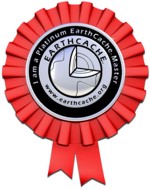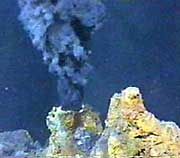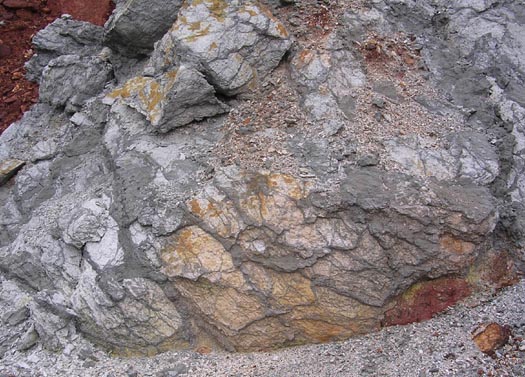From the guidelines: "People do not need to wait for permission to log your EarthCache. Requiring someone to wait is not supported by the EarthCache guidelines. People should send their logging task answers to you, then log your EarthCache. When you review their logging task answers, if there is a problem, you should contact them to resolve it. If there is no problem, then their log simply stands."

What can you learn from this EarthCache? This is a simple EarthCache that demonstrates one particular feature of Volcanogenic Massive Sulphide deposits so typical of the Iberian Pyrite Belt: the stockwork ore zones.
 Location - The stockwork is located on the northern side of the Mina de S. Domingos open pit in SE Portugal.
Location - The stockwork is located on the northern side of the Mina de S. Domingos open pit in SE Portugal.
How can you log this EarthCache? – Walk to the given coordinates. Access is past the information boards on the western side of the open pit. The terrain is 3.5*. Take appropriate shoes and be careful not to slip and fall.
In front of the stockwork please answer the following questions:
1- What is the average thickness of the mineralized veins?
2- What are the dominant colours associated with this stockwork zone? (greys, purples, greens, yellows, oranges or reds).
3- What is the area is occupied by the stock work zone?
If you think you have the right answers, log the cache but ALSO send me the answers via my profile with the following information:
- Identification of the cache
- Answers
- (please click: I want to send my e-mail along with this)

If I don’t answer you it is because you have passed the test.
Do not place pictures of the stockwork in the logs. Spoiler logs will be deleted.
What is a stockwork? - The name Stockwork (derived from the German, stockwerk, is usually applied to large masses of rock impregnated with metallic ores or intersected by a number of mineral veins at short distances apart, sometimes crossing one another in all directions. Stockworks are common in many ore deposit types where they are a mineral deposit in the form of a network of veinlets diffused in the country rock. They are also referred to as stringer zones.
Where do they form? – These are typical of Volcanogenic massive sulphide ore deposits (VMS) are a type of metal sulphide ore deposit, mainly Cu-Zn-Pb which are associated with and created by volcanic-associated hydrothermal events in submarine environments.
These deposits are also sometimes called volcanic-hosted massive sulphide (VHMS) deposits. They are predominantly layered accumulations of sulphide minerals that precipitate from hydrothermal fluids on or below the seafloor in a wide range of ancient and modern geological settings. In modern oceans they are synonymous with sulfurous plumes called black smokers.
Volcanogenic massive sulphide deposits are forming today on the seafloor around undersea volcanoes along many mid ocean ridges, and within back-arc basins and forearc rifts. Mineral exploration companies are exploring for seafloor massive sulphide deposits; however, most exploration is concentrated in the search for land-based equivalents of these deposits.
How do they form? - The source of metal and sulfur in VMS deposits is a combination of incompatible elements that are leached from footwall rocks in the sub-seafloor hydrothermal alteration zone by hydrothermal fluid circulation. Hydrothermal circulation is generally considered to be driven via heat in the crust often related to deep-seated igneous intrusions.
Transport of metals occurs via convection of hydrothermal fluids, the heat for this supplied by the magma chamber and subvolcanic intrusions that lie below the volcanic edifice. Cool ocean water is drawn into the hydrothermal zone and is heated by the volcanic rock and is then expelled into the ocean, the process enriching the hydrothermal fluid in sulfur and metal ions.
The ore materials are precipitated within a fumarole field or a black smoker field when they are expelled into the ocean, cool and mix with seawater resulting in the precipitation of sulfide minerals as stratiform sulfide ore.

VMS deposit morphology - VMS deposits have a wide variety of morphologies, with mound shaped and bowl shaped deposits most typical. The bowl-shaped formations formed due to venting of hydrothermal solutions into submarine depressions.
VMS deposits have an ideal form of a conical area of highly altered volcanic or volcanogenic sedimentary rock within the feeder zone, which is called the stringer sulfide or stockwork zone, overlain by a mound of massive exhalites, and flanked by stratiform exhalative sulfides known as the apron. The stockwork zone typically consists of vein-hosted sulfides (mostly chalcopyrite, pyrite, and pyrrhotite) with quartz, chlorite and lesser carbonates and barite.
The mound zone consists of laminated massive to brecciated pyrite, sphalerite (+/-galena), hematite, and barite. The mound can be up to several tens of metres thick and several hundred metres in diameter.
References:
Le Neve Foster, C. 1978. On some Tin Stockworks in Cornwall. V. 126, n1-4, p. 654-659.Santaguida, F., and Hannington, M., 1996, Characteristics of gold mineralization in massive sulphide deposits of the Notre Dame Bay area, Central Newfoundland: Canadian Journal of Earth Sciences, v. 33, p. 316-334.
Sillitoe, R. Hannington, M. and Thompson, J., 1996. High sulphidation deposits in the volcanogenic massive sulphide deposit environment. Economic Geology 91, p.204-212.
Galley, A.G., Hannington, M.D., Jonasson, I.R., 2007. Volcanogenic massive sulphide deposits. Goodfellow WD Edition.
Hannington, M.D., Jamieson, J., Monecke, T., and Petersen, S., 2010, Modern seafloor massive sulfides and base metal resources – Towards a global estimate of seafloor massive sulfide potential: Society of Economic Geologists Special Publication 15, p. 317-338.
Hocking, M.W., Hannington, M.D., Percival, J.B., Stoffers, P., Schwarz-Schampera, U., and de Ronde, C.E.J., 2010, Clay Alteration of Volcaniclastic Material in a Submarine Geothermal System, Bay of Plenty, New Zealand: Journal of Volcanology and Geothermal Research, v. 191, no. 3-4, p. 180-192.

O que podes aprender com esta EarthCache? - Ao visitares esta EC irás ter contacto com uma característica particular dos depósitos vulcanogénicos da Faixa Piritosa Ibérica: a zona de stockwork.
Localização - Esta EC está localizada dentro da corta da Mina de São Domingos.
 Para registares o teu found nesta EC tens de entrar na corta passando pelos painéis informativos em direcção à água na corta. O GZ está no flanco Norte da corta. Tendo em conta que o terreno é de 3.5* leva sapatos adequados para não caíres e se forem crianças, que estas estejam bem seguras pela mão de um adulto responsável.
Para registares o teu found nesta EC tens de entrar na corta passando pelos painéis informativos em direcção à água na corta. O GZ está no flanco Norte da corta. Tendo em conta que o terreno é de 3.5* leva sapatos adequados para não caíres e se forem crianças, que estas estejam bem seguras pela mão de um adulto responsável.
Quando estiverem frente ao stockwork respondam às seguintes perguntas:
1- Qual é a média da espessura dos vénulos mineralizados?
2- Quais são as cores predominantes associadas com esta zona de stockwork ?(cinzentos, roxos, verdes, amarelos, laranjas ou encarnados).
3- Quanto mede a área desta zona de stockwork?
Se pensas que passate no teste faz o log de found mas envia-me também as respostas com a 1- a identificação da cache; 2- respostas e selecciona “I want to send my e-mail along with this message.” Se não te responder é porque passaste no teste e estás de parabéns. Caso contrário irás receber uma resposta.
Não coloquem fotos do stockwok nos logs. Logs com spoilers serão eliminados.
O que é um stockwork? Palavra derivada do Alemão, STOCKWERK, é uma rede interligada de vénulos mineralizados. Por vezes são só por si um jazigo mineral e podem ser referidos como zona de stringers.
 Onde se formam? São típicos de depósitos vulcanogénicos de sulfuretos maciços que são um tipo de depósito principalmente mineralizado em Cu-Zn-Pb que estão associados com e gerados por actividade vulcânica associado a eventos hidrotérmais em ambientes submarinos.
Onde se formam? São típicos de depósitos vulcanogénicos de sulfuretos maciços que são um tipo de depósito principalmente mineralizado em Cu-Zn-Pb que estão associados com e gerados por actividade vulcânica associado a eventos hidrotérmais em ambientes submarinos.
São predominantemente acumulações de camadas de minerais de sulfureto que precipitam a partir de fluidos hidrotermais no fundo do mar ou abaixo do fundo do mar numa ampla gama de antigos e modernos ambientes geológicos. Nos oceanos modernos são sinónimos de chaminés vulcânicas que emitem um “fumo” preto e são denominados fumarolas negras.
Como se formam? - A fonte de metal e enxofre nestes depósitos é uma combinação de elementos incompatíveis que são lixiviados das rochas encaixantes na zona de alteração por circulação de fluido hidrotermal. O transporte de metais ocorre por convecção de fluidos hidrotermais, o calor fornecido pela câmara de magma e intrusões subvulcânicas que se encontram abaixo do edifício vulcânico. Água do mar fresca é canalizada para a zona de fluxo hidrotermal e é aquecida e expelida para o oceano enriquecida em iões de enxofre e de metal.
O minério precipita dentro de um campo ou num campo de fumarolas negras são expelidos para o oceano, arrefecem e misturam com a água do mar, resultando na precipitação de sulfuretos numa camada estratiforme.
Morfologia dos depósitos – São idealmente de forma cónica e contêm de uma variedade de rochas vulcânicas e sedimentares muito alteradas pela circulação de fluidos hidrotermais. São compostos por uma zona de alimentação (a zona de stockwork), sobreposta e ladeada de uma zona de exalativos.

 The most exciting way to learn about the Earth and its processes is to get into the outdoors and experience it first-hand. Visiting an Earthcache is a great outdoor activity the whole family can enjoy. An Earthcache is a special place that people can visit to learn about a unique geoscience feature or aspect of our Earth. Earthcaches include a set of educational notes and the details about where to find the location (latitude and longitude). Visitors to Earthcaches can see how our planet has been shaped by geological processes, how we manage the resources and how scientists gather evidence to learn about the Earth. To find out more click HERE.
The most exciting way to learn about the Earth and its processes is to get into the outdoors and experience it first-hand. Visiting an Earthcache is a great outdoor activity the whole family can enjoy. An Earthcache is a special place that people can visit to learn about a unique geoscience feature or aspect of our Earth. Earthcaches include a set of educational notes and the details about where to find the location (latitude and longitude). Visitors to Earthcaches can see how our planet has been shaped by geological processes, how we manage the resources and how scientists gather evidence to learn about the Earth. To find out more click HERE.